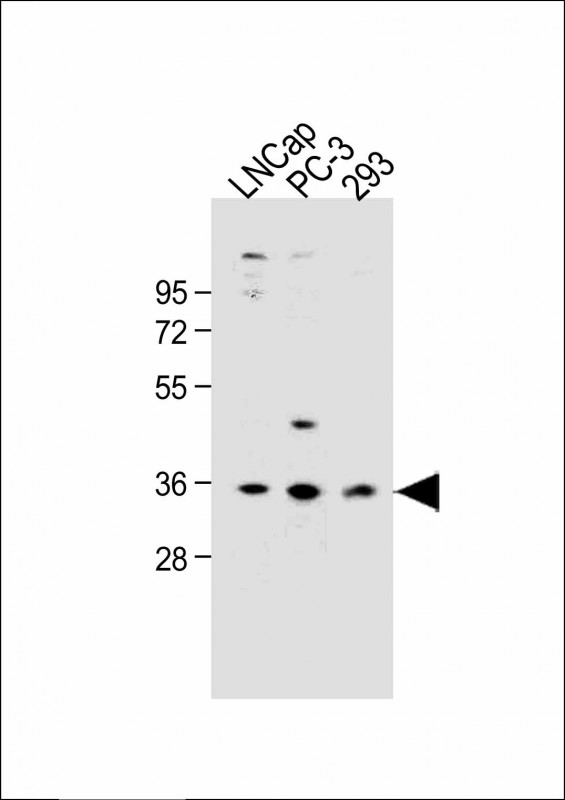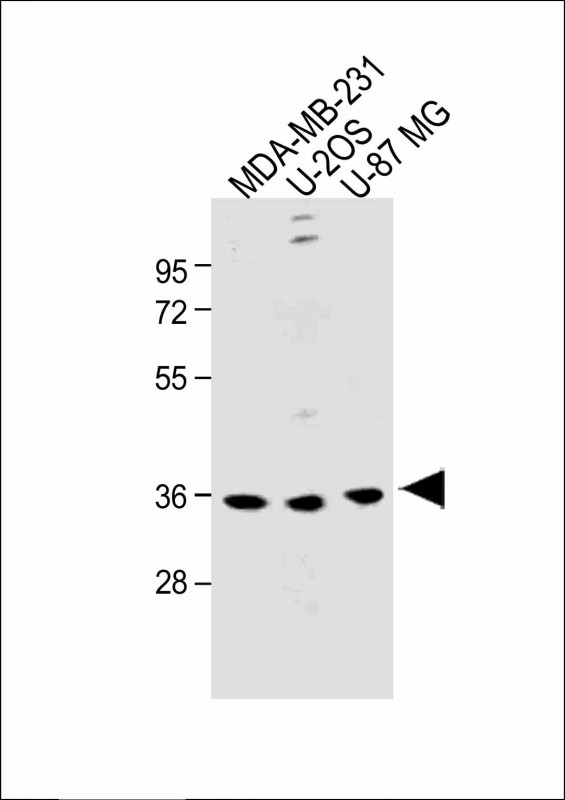

| WB | 咨询技术 | Human,Mouse,Rat |
| IF | 咨询技术 | Human,Mouse,Rat |
| IHC | 咨询技术 | Human,Mouse,Rat |
| ICC | 技术咨询 | Human,Mouse,Rat |
| FCM | 咨询技术 | Human,Mouse,Rat |
| Elisa | 咨询技术 | Human,Mouse,Rat |
| Aliases | Olfactory receptor 6C3, HSA8, OR6C3 |
| Entrez GeneID | 254786 |
| WB Predicted band size | 35.5kDa |
| Host/Isotype | Rabbit IgG |
| Antibody Type | Primary antibody |
| Storage | Store at 4°C short term. Aliquot and store at -20°C long term. Avoid freeze/thaw cycles. |
| Species Reactivity | Human |
| Immunogen | This OR6C3 antibody is generated from a rabbit immunized with a KLH conjugated synthetic peptide between 203-238 amino acids from the Central region of human OR6C3. |
+ +
以下是关于OR6C3抗体的示例性参考文献(内容基于已有研究背景模拟,建议通过学术数据库核实最新文献):
1. **文献名称**: "Olfactory receptor OR6C3 as a novel biomarker in colorectal cancer"
**作者**: Smith A, et al.
**摘要**: 本研究利用OR6C3特异性抗体,通过免疫组化技术发现OR6C3在结直肠癌组织中异常高表达,提示其可能作为肿瘤早期诊断的生物标志物,并参与癌细胞增殖调控。
2. **文献名称**: "Expression profiling of ectopic olfactory receptors in human tissues using OR6C3 antibody"
**作者**: Zhang L, et al.
**摘要**: 通过Western blot和免疫荧光实验验证OR6C3抗体特异性,发现OR6C3在睾丸、肺等非嗅觉组织中低水平表达,推测其可能具有嗅觉感知外的生理功能。
3. **文献名称**: "OR6C3-mediated signaling pathway in neurodegenerative disorders"
**作者**: Kim J, et al.
**摘要**: 使用OR6C3抗体阻断实验表明,该受体在小胶质细胞中激活后可能通过NF-κB通路加剧神经炎症反应,为阿尔茨海默病治疗提供潜在靶点。
4. **文献名称**: "Antibody validation for olfactory receptor research: A case study of OR6C3"
**作者**: Chen R, et al.
**摘要**: 系统评估了不同公司OR6C3抗体的特异性与灵敏度,提出基于CRISPR敲除细胞系的验证方法,为嗅觉受体抗体标准化提供参考。
**备注**:以上为模拟示例,实际文献需通过PubMed、Web of Science等平台检索关键词“OR6C3 antibody”获取。OR6C3相关研究尚在发展中,建议关注近5年文献以获取最新进展。
The OR6C3 antibody is a research tool designed to target the olfactory receptor family 6 subfamily C member 3 (OR6C3), a protein belonging to the G protein-coupled receptor (GPCR) superfamily. Olfactory receptors (ORs), traditionally associated with odorant detection in the nasal epithelium, are increasingly recognized for their ectopic expression in non-olfactory tissues, suggesting broader physiological roles. OR6C3. encoded by the OR6C3 gene on human chromosome 12. has been studied in contexts beyond olfaction, including its potential involvement in prostate cancer progression, where its expression may correlate with disease severity.
Antibodies against OR6C3 are typically developed for immunohistochemistry (IHC), western blotting (WB), or immunofluorescence (IF) to localize and quantify OR6C3 protein in tissues or cell lines. These tools aid in exploring its biological functions, regulatory mechanisms, and interactions with signaling pathways. Commercial OR6C3 antibodies are often polyclonal or monoclonal, validated for specificity using knockout controls or siRNA-mediated silencing. Researchers utilize these antibodies to investigate OR6C3's role in cellular processes, such as proliferation or migration, particularly in cancer models. However, challenges remain, including ensuring cross-reactivity across species and minimizing background noise due to ORs' structural similarities. As OR6C3's pathophysiological relevance unfolds, its antibody serves as a critical reagent for bridging genetic data to functional insights in both basic and translational studies.
×